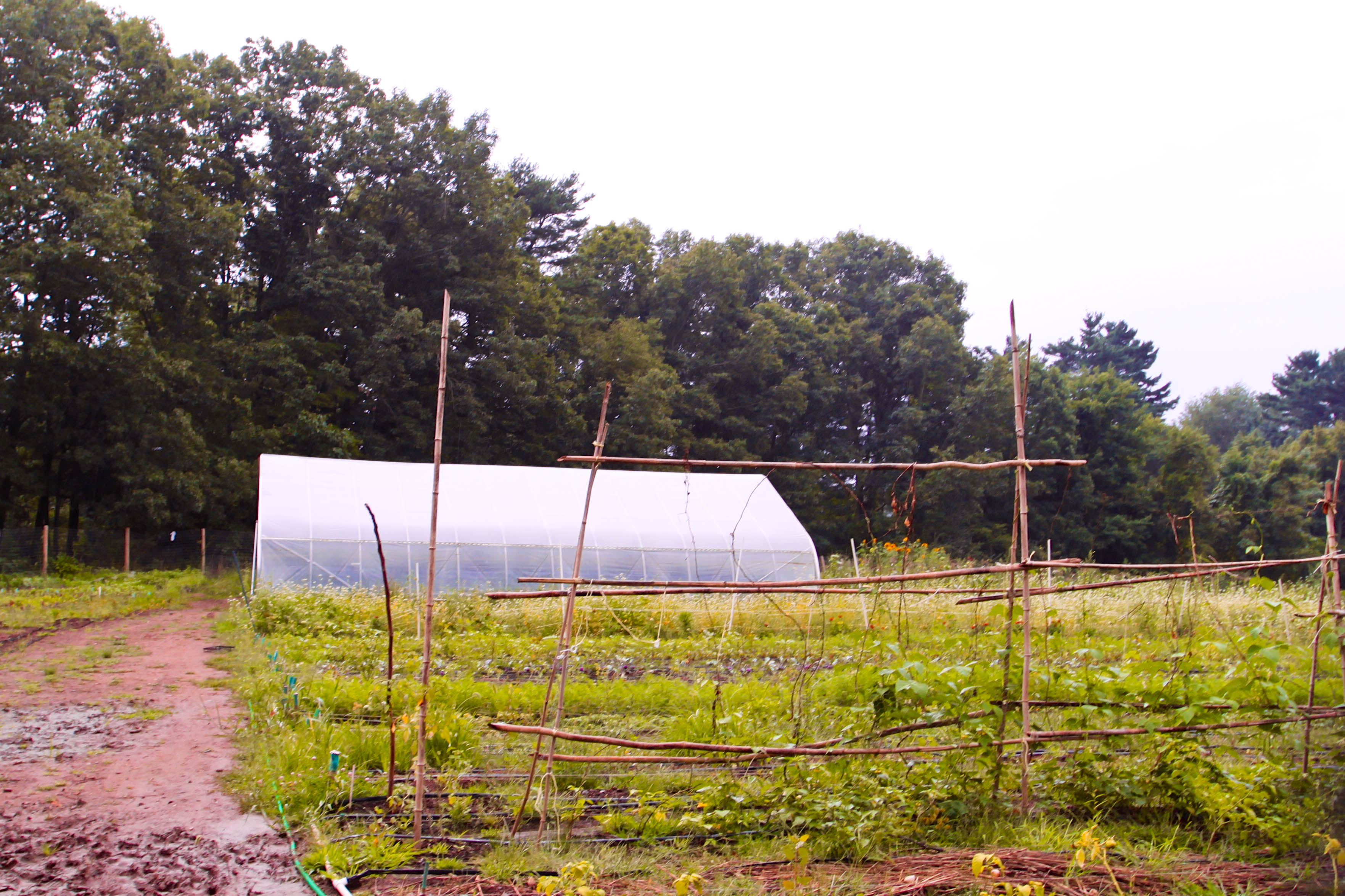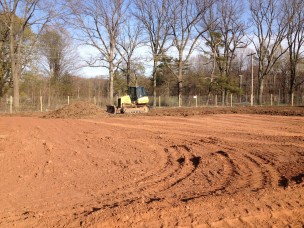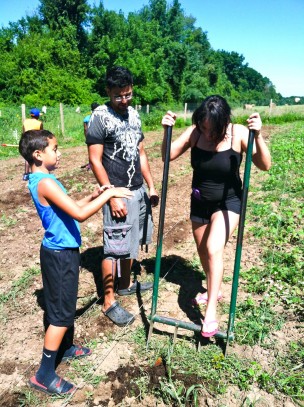Someone who visited Long Lane Farm about half a year ago might have felt like ze was stepping onto the surface of Mars. An unexpected discovery of pesticides last winter compelled the farmers to replace the top 18 inches of soil, leaving the farm bare, rocky, and desolate. Following a bustling few months of intensive remediation, however, the farm is well on its way back to being a place of greenery and growth.
From the Track to the Farm: Remediating the Soil
Things were running smoothly on the farm until last winter, when the State of Connecticut found that Long Lane’s soil contained trace elements of illegal pesticides from the practices of its previous owners, the juvenile correctional facility Long Lane School for Girls. This finding triggered a large soil replacement project that entailed rebuilding the farm from scratch.
“The only legal option for the University was to have the first 18 inches of topsoil removed from the whole farm,” explained Joshua Krugman ’14, who is active on the farm.
This was upsetting news for the Long Lane Collective, the group of students and faculty who keep the farm running.
“The Farm was completely obliterated,” wrote Assistant Professor of Anthropology and The Science in Society Program Gillian Goslinga, who is the Long Lane Collective’s faculty advisor, in an email to The Argus. “More than 10 years of cultivation and care were wiped out in a just a few weeks.”
After removing the contaminated soil, the farmers set out to replace it with soil from Wesleyan’s track, which was replaced with Astroturf last year.
“That was good because it was local soil—it didn’t have a big carbon footprint,” Krugman said. “But it was also not good because it was mostly clay and rocks, not very good soil to be farming with.”
The farmers recalled the challenges of working with the new soil, which couldn’t replace the nutritional benefits of the soil they had been working with for years.
“The replacement soil from the old athletic field was squeaky clean, but it was also nutrient deficient and primarily clay and completely impacted by the bulldozers,” Goslinga wrote. “This is why most of our root vegetables failed despite the long hours the student farmers put in to turn over and aerate the soil before planting in May, and why many seedlings did not blossom into robust plants as they had in the nutrient rich soils of earlier years.”
Part of the Long Lane Collective’s philosophy is to do everything on the farm by hand, which made the challenge of remediating the soil even more daunting.
“In June, we worked really, really hard, because we don’t use any mechanical tools at all. We have one lawnmower, but we barely use it, and that’s the one mechanical thing we have,” said Rebecca Sokol ’15, who is also active on the farm. “So we basically had to till all the fields by hand, using hand tools, and that took a really long time and was very exhausting.”
However, the team was able to increase the farm’s acreage, doubling it’s original size.
“So now we’re bigger than we’ve ever been,” Sokol said.
Other farmers agreed that rebuilding the farm proved to be a useful experience.
“This year’s been really exciting because we’ve gotten the opportunity to learn how to build a farm from scratch, and from very poor soil conditions,” Krugman said.
Goslinga commended the students who helped out with the remediation process for their diligence.
“The students approached each challenge as a learning opportunity, consulting scientific journals and soil and plant scientists, doing Internet research, and talking with organic farmers in their local and regional network of supporters about what to do,” she noted. “That’s why they are ‘scholar-farmers’ to me.”
Some plants on the farm did not fare so well in light of the soil remediation, but others thrived. There were some surprises along the way, too.
“We basically still have pretty low soil fertility and pretty poor drainage, because clay doesn’t drain very well,” Krugman said. “That has impeded the growth and flourishing of some of the crops we planted, but we’re basically acting as if everything is normal and planting as if we have normal soil, and it just happens that some things do quite well, and we’re learning [what those are] as we go. Some of our beans have done really well, our tomatoes have been fantastic, the husk cherries and tomatillos are great, and the peppers are great. There have been some real successes.”
At the same time, some of the farm’s more marketable crops–ones that the farmers usually sell to Bon Appétit Management Company and at the Middletown Farmer’s Market–didn’t fare so well.
“Most of our leafy greens, which are usually our bread and butter at the market, were basically a total disaster: kale, collards, bok choi, chard, spinach, lettuce, et cetera,” Krugman said. “But it was interesting to see how much we could do with what we had. It took some creativity to have enough for the different people to whom we have obligations—we had to use more little niche crops.”
One niche crop that they experimented with this season is quinoa.
“We know the quinoa grain is edible, but it turns out the leaves are also edible,” Krugman said. “They have more calcium and iron than spinach.”
Summer Farming and the Middletown Food Project
To help out with the remediation process, as well as to facilitate some other ongoing projects at Long Lane Farm, 10 students stayed in Middletown over the summer to continue their work.
“We had 10 farm workers this summer, which is our all time high. We had two juniors, five sophomores, and three freshmen,” Krugman said. “There was a pretty good balance of ages—a healthy crop of sophomores, the middle of the bell curve.”
Hailey Sowden ’15, one of the students who stayed on the farm this summer, noted that it was great to be involved in the process of rebuilding Long Lane.
“It was incredible to see the transformation, because in late May and early June, it was just a mud pile,” she said. “The whole farm was alternating between being a giant mud flat and then [desert-like], cracked earth, and now it’s very green. Knowing that that happened during those three months is incredible.”
Among the activities these ten students took on this summer was running the Middletown Food Project, a Community-Supported Agriculture (CSA) program that engaged six low-income families from a government-subsidized Middletown neighborhood. The project brought the families and the farmers together for a series of food-related activities and workshops.
“They would come every Saturday with their kids, and we would have a workshop where we would play games with the kids and teach them in a fun way about farming [and] about plants,” explained Sokol, who stayed on the farm this summer. “With the adults, we would teach them in a more serious way: we had some cooking seminars with them, and at the end we would give them a bunch of produce to take home, and it was free for them,” she added. “It was really, really fun.”
Sokol said that, despite some initial concerns she had about the project seeming patronizing, it ultimately didn’t feel that way.
“It definitely could have felt like, ‘Let us teach you. You don’t know,’” Sokol said. “And we didn’t want it to be that way, and I was scared that it might have turned out that way. But instead we all just hung out and we would teach them and they were really interested.”
Sowden noted that the collaborative nature of the Middletown Food Project made it one of her favorite experiences during her summer stay in Middletown.
“The families have been really involved in shaping the project, and it’s less of a top-down kind of thing and much more horizontally run—us and the families together,” she said.
Living and Working Together
The students who stayed to work on the farm this summer also lived together, keeping with the Long Lane Collective’s history of engaging in social experiments in addition to its farming endeavors.
“One of the interesting things about the farm besides the fact that we do small-scale ecological agriculture with no synthetic fertilizers or pesticides and also no gas-powered machines [is that] we are undertaking a social experiment of running ourselves as a horizontal collective,” Krugman said. “People are sometimes in charge of various parts of the operation, but we make all our decisions by consensus. No one has the final say.
This philosophy fed into their living situation this summer, when the students took turns cooking for each other and maintaining their two, shared apartments on Lincoln Street.
“That’s one of the interesting areas of continuity over the ten-year history of the farm—this shared interest in community life and farm life and how the two can be sort of structured in a different way than they are usually in our culture,” Krugman said.
Prospects for The Year Ahead
Although the farm has come a long way since the spring, it’s still going through a long-term recovery process. Still, that isn’t stopping the members of the Long Lane Collective from moving ahead. They continue to sell their crops to Bon Appétit, and they keep a table at the Middletown Farmers’ Market. They are also in the process of bringing in a new crop of farmers.
“In the fall we recruit new members to the Collective so that one generation of students can pass on the farm to the next,” Goslinga wrote. “We’re also organizing with the Admissions Office a schedule of tours of the farm for prospective students. This is a generation very interested in the potential of community-based organic farming to address at local and regional levels pressing issues of social justice and the environmental crisis.”



Comments are closed